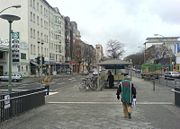.gif)
Wedding (Berlin U-Bahn)
Encyclopedia

Wedding (Berlin)
Wedding is a locality in the borough of Mitte, Berlin, Germany and was a separate borough in the north-western inner city until it was fused with Tiergarten and Mitte in Berlin's 2001 administrative reform...
of Berlin
Berlin
Berlin is the capital city of Germany and is one of the 16 states of Germany. With a population of 3.45 million people, Berlin is Germany's largest city. It is the second most populous city proper and the seventh most populous urban area in the European Union...
with the same name
Wedding (Berlin)
Wedding is a locality in the borough of Mitte, Berlin, Germany and was a separate borough in the north-western inner city until it was fused with Tiergarten and Mitte in Berlin's 2001 administrative reform...
and serves the S-Bahn
Berlin S-Bahn
The Berlin S-Bahn is a rapid transit system in and around Berlin, the capital city of Germany. It consists of 15 lines and is integrated with the mostly underground U-Bahn to form the backbone of Berlin's rapid transport system...
lines and and the U-Bahn
Berlin U-Bahn
The Berlin is a rapid transit railway in Berlin, the capital city of Germany, and is a major part of the public transport system of that city. Opened in 1902, the serves 173 stations spread across ten lines, with a total track length of , about 80% of which is underground...
line .
S-Bahn station
Wedding S-Bahn station first opened on 1 May 1872. It is part of the Berlin Ringbahn, a circular line traversing many of the central districts of the city. The service, however, was disrupted in 1961 by the building of the Berlin WallBerlin Wall
The Berlin Wall was a barrier constructed by the German Democratic Republic starting on 13 August 1961, that completely cut off West Berlin from surrounding East Germany and from East Berlin...
and Wedding S-Bahn station went out of use in 1980 after passenger numbers on the route fell to unsustainable levels.
After the fall of the Berlin Wall, many disused S-Bahn routes were gradually reinstated. The section of line between the stations Westhafen and Gesundbrunnen, with Wedding as the only intermediate station, was the last of these to be reopened. This occurred on 16 June 2002, a date which was nicknamed Wedding-Day, a pun based on the clash of meanings of the word 'wedding' in English and German.
U-Bahn station
Wedding U-Bahn station first opened on 8 March 1923 along with the rest of the newly-built line between the stations Stettiner Bahnhof (now Naturkundemuseum) and SeestraßeSeestraße (Berlin U-Bahn)
Seestraße is a station in the Wedding district of Berlin which serves the and is operated by the BVG. It lies at the busy intersection of Müllerstraße and Seestraße, which are two of Wedding's principal shopping streets and thoroughfares.-Overview:...
. It was opened bearing the name Bahnhof Wedding (Wedding station), reflecting the fact that there existed interchange with the adjoining station served by long-distance trains. It was given its current name in 1972 as the station no longer existed, and has greatly increased in significance since 2002 when the interchange with the S-Bahn was reinstated.
Other transport links
In addition to its rail links, the station is also served by two busBus
A bus is a road vehicle designed to carry passengers. Buses can have a capacity as high as 300 passengers. The most common type of bus is the single-decker bus, with larger loads carried by double-decker buses and articulated buses, and smaller loads carried by midibuses and minibuses; coaches are...
lines during the day (one of which runs continuously) and two at night
Night bus
A night bus service or owl service is a public transport bus service which operates through the night time hours. Many cities operate such services, either in addition to or in substitution for ordinary daytime bus services or rapid transit rail services which may shut for maintenance or due to...
. The nearby Nettelbeckplatz was once a major hub for tram
Tram
A tram is a passenger rail vehicle which runs on tracks along public urban streets and also sometimes on separate rights of way. It may also run between cities and/or towns , and/or partially grade separated even in the cities...
lines, but these were removed in 1958.

